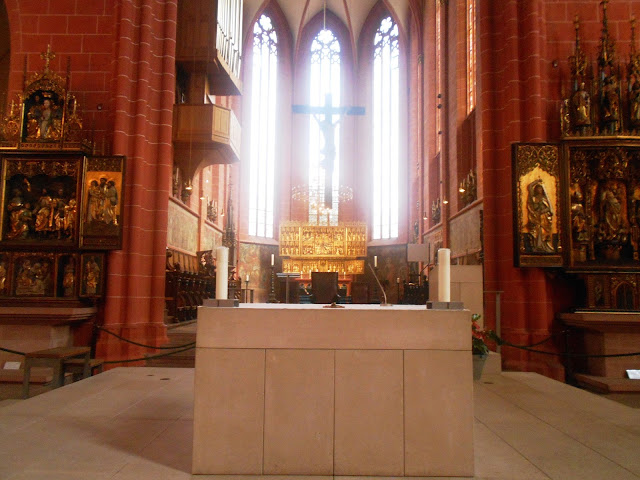Up until 1792, so-called electors head to
this cathedral to elect the emperor of an empire that exists in name only. In fact, from the 16th century until dissolution, the Holy Roman Empire founded by the Charlemagne in the middle ages, was, but a mere collection of innumerable German states and kingdoms, each having its own sovereign ruler.
The elector-Archbishop of Mainz, who presides among the electors summons a delegation of kings, princes, dukes, counts and church officials to cast their vote. The election itself is merely a ceremonial one, for since 1438 until 1792, the heads of the House of Austrian House of Hapsburg were understood to be automatically elected as leaders of an empire that exists in name only. Only once, from 1740-1745 was a member of the House of Hapbsburg not elected.
The elector-Archbishop of Mainz, who presides among the electors summons a delegation of kings, princes, dukes, counts and church officials to cast their vote. The election itself is merely a ceremonial one, for since 1438 until 1792, the heads of the House of Austrian House of Hapsburg were understood to be automatically elected as leaders of an empire that exists in name only. Only once, from 1740-1745 was a member of the House of Hapbsburg not elected.
My eight-hour tour of Altstadt and Sachenhausen was possible because of my long layover. I started my walk from the Hauptwacht station to Altstadt until my heart melted with joy at the sight of Romerberg Frankfurt’s oldest, busiest, and most picturesque square. You get that unexplainable feeling of utter joy when you've finally seen a place you only used to see on books and then, all of a sudden, you're right there in front of it? Chances like this seldom happen, at least to an ordinary person like me and it's stupefying.
Now, back to Romerberg - it's the first destination that tourists usually take when doing a tour of the Old Town. Here you'll also find some of the oldest, prettiest buildings in the whole of Frankfurt.
Nearby is the St. Paul Church, the ancient Lutheran church with its 51 bells, 4 of which are used for peals, the rest for carillons. A catholic church originally stood here until the the mid-15th century when the present structure was build. It is the only structure in Romerberg that has survived intact after the the bombing of Frankfurt during the War.
Now, back to Romerberg - it's the first destination that tourists usually take when doing a tour of the Old Town. Here you'll also find some of the oldest, prettiest buildings in the whole of Frankfurt.
Nearby is the St. Paul Church, the ancient Lutheran church with its 51 bells, 4 of which are used for peals, the rest for carillons. A catholic church originally stood here until the the mid-15th century when the present structure was build. It is the only structure in Romerberg that has survived intact after the the bombing of Frankfurt during the War.
The Ostzeile is a series of
half-timbered houses you thought was plucked from the Alpine countryside. The
original houses, which were originally built during the medieval period, were
destroyed during the bombings in 1944. What you see today were just replicas
built in the 1980s. Six prominent houses stand, each bearing a name: Kleiner
Laubenberg (Little Laubenberg), Großer Laubenberg (Large Laubenberg) , Wilder
Mann (Wild Man), Kleiner Dachsberg-Schlüssel (Little Dachsberg), Goldener Greif
(Golden Griffin) and Zum Engel (At the Angel). They make a perfect backdrop when taking
pictures!
Deeper into the heart of Romerberg the
statue of Justitia (Gerechtigkeitsbrunnen) should stand. It is the eight-cornered
fountain first inaugurated in 1543. She is the city’s self-image. However, it
is nowhere to be seen. Romerberg was undergoing a restoration work that time,
so perhaps, the conservators plucked here and brought her somewhere else where
they could set her back to her glorious looks.
Opposite Old St. Nicholas church is the
Romer, the town hall (Rathaus) of Frankfurt for over 600 years. Named after the merchant family who built it,
the building was sold to the city council, which converted it into the town
hall.
A walk further from Romerberg, along
Fahrtor, is the Historical Museum (Historisches Museum). It occupies the
Saalhof since 1955 with an extension added in 1972. The museum features cultural and historical objects relating to the
history of Frankfurt and Germany, from the medieval period to the contemporary
times.
The Iron Footbridge (Eiserner Steg )
just outside the museum offers lazy strollers the chance to enjoy the beautiful
Main River. It connects Altstadt to Sachsenhausen. The original wrought iron bridge
was built in 1868 and was replaced in 1911 by a slightly larger cantilever
bridge. The bombings damaged it until it was rebuilt after the war.
A walk down history lane does not end when
you reach the Iron Footbridge. Sachsenhaus has museums, churches, and charming
houses that are worth appreciating, too! And that means, my walking tour around Frankfurt isn't ending yet.

































0 Comments